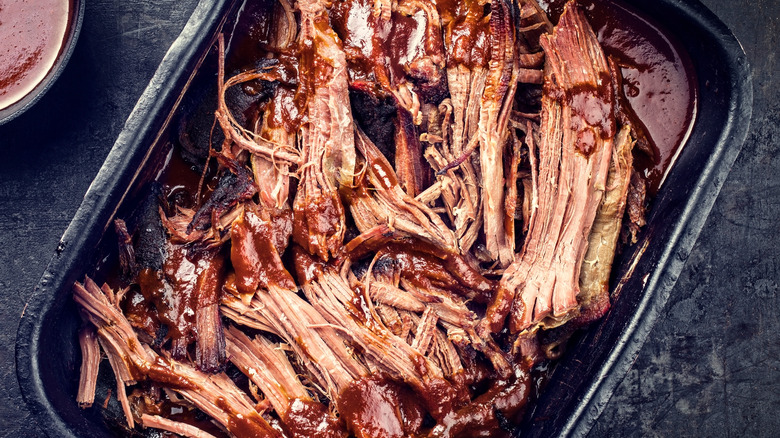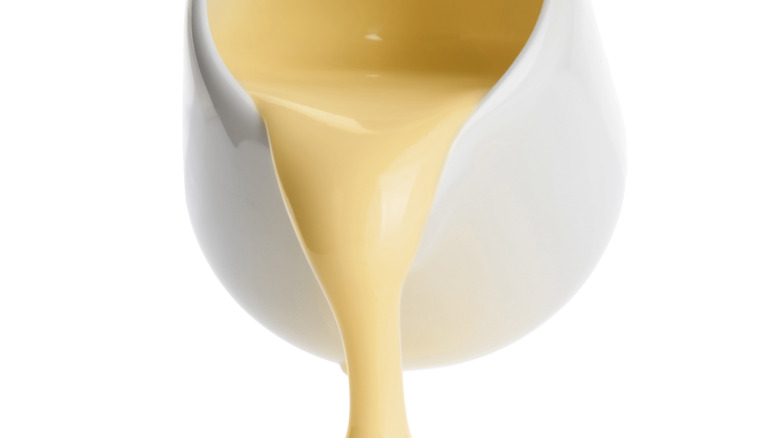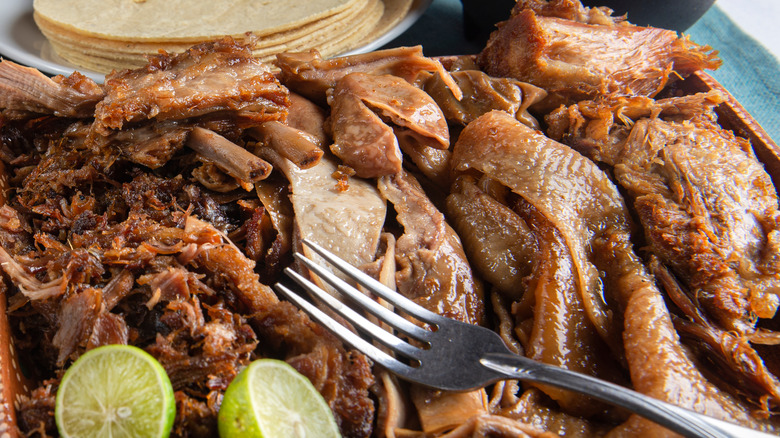Canned Sweetened Condensed Milk Is The Secret To Deliciously Caramelized Pork
Why is carnitas so wonderful? Let us count the ways. It's fatty, deeply savory, tender, and profoundly caramelized with a deep, burnished bark rivaled only by barbecue. Traditionally, the process for making carnitas involved a long, slow cooking process by which various cuts of pork are gently cooked in lard, spices, and other ingredients in large copper vessels. The result is delicious but difficult to repeat at home. In lieu of several pieces of pork, home cooks often turn to pork shoulder for carnitas, along with finding at-hand adjustments for the traditional flavoring agents used. To get the necessary caramelization just right, there is a secret weapon that may already be hiding out in your pantry. Sweetened condensed milk helps build color while also adding just the right balance to the slightly spicy and savory elements of carnitas.
Sweetened condensed milk is a product that dates before common refrigeration. This shelf-stable milk has roughly 60% of its water content removed as a measure to counteract spoilage before being sealed in airtight cans. As the name implies, sugar is added; this being the main distinction between sweetened condensed milk and evaporated milk.
It makes sense, too, that sweetened condensed milk works well with carnitas. Many traditional — and larger — recipes call for whole milk to be added to the pot. This also aids in caramelization, but not as effectively on smaller batches. That's why sweetened condensed milk, with its density and added saccharine nature, helps speed things along.
How sweetened condensed milk caramelizes
It might seem counterintuitive to add such a thick, creamy substance to something that you want to caramelize. Generally, when one wants to create a wonderfully brown exterior on a piece of meat or a vegetable, the heat is turned up high, and moisture is the enemy. But the secret here is in the slow cooking.
As the carnitas braise in the pot, the sweetened condensed milk starts to change. The sugar that is incumbent to the milk itself, as well as the added sugar, starts to brown in the heat. It's the same reason sweetened condensed milk is used to make dulce de leche. This caramelization is the first step towards the finished product. Once the lid is pulled from the pot, the water begins to evaporate, leaving behind the meat, fats, and sugars. The carnitas begins to sear in its own fat and the sugars that are left behind coating the pork further caramelize around the exterior. When all is said and done, the carnitas have a slightly sweet exterior that has the characteristic beautiful brown color thanks to the sweetened condensed milk.
Cooking the carnitas
To make carnitas at home, you really only need a large cooking vessel, like a Dutch oven, that can accommodate an entire pork shoulder (three to five pounds), along with the other ingredients. After seasoning with salt, the pork should be seared on all sides to help build the flavor and crust. Then, you add spices and aromatics, such as onion, garlic, oregano or marjoram, cumin, and cloves. These can, of course, be adjusted, augmented, and omitted as you see fit. For example, some people add cinnamon or chiles; others don't care for clove or garlic.
This is also where, traditionally, lard would come into play. With a pork shoulder at home, the fat that is rendered out should be sufficient. A little water is all that will be needed to help keep the pork moist and cooking. After the pork shoulder, aromatics, and water come to a simmer, add in a tablespoon or two of sweetened condensed milk and a little juice, zest, or slices of orange, a traditional flavoring. Some folks even like to add a little cane sugar or "Mexican" Coca-Cola, which has real sugar in place of high fructose corn syrup to further add flavor and aid caramelization. Allow the mixture to simmer covered for a few hours before uncovering and allowing a good portion of the liquid to evaporate and brown. After this, the pork can be shredded, ready to fill tacos, top nachos, or fit any other use you may have.


